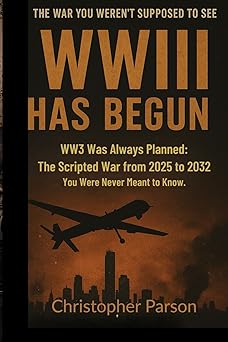
Christopher Parson’s WW3 Has Begun arrives as a confident, argumentative work that blends geopolitics, conspiracy theory, and speculative forecasting into a single, polemical volume. The book’s subtitle and marketing position it as an exposé: a grand narrative in which twentieth- and twenty-first-century power shifts are not accidents but the results of long-running, intentional designs. It presents itself as uncovering insider insights, suppressed letters, and military doctrines that allegedly reveal a hidden three-phase war plan stretching back centuries.
What the book sets out to do
Parson’s explicit aim is to persuade readers that the geopolitical changes beginning in the mid-2020s — the collapse or marginalization of Europe and the simultaneous ascent of parts of Asia — are the product of carefully scripted strategies rather than messy, contingent events. The narrative is arranged as both chronological and thematic: a short historical preface, a reconstruction of the alleged plan and its purported architects, and a sequence of case studies that tie present-day crises to that long game. Along the way, Parson mixes reportage-style anecdotes, selective archival claims, and a running interpretive frame that reads recent events as pieces of a single engineered puzzle.
Strengths
Parson is a strong storyteller. He writes with a voice that’s confident, punchy, and designed to keep a reader hooked. The book’s structure — alternating between sweeping claims and granular anecdotes — creates momentum; when he describes events or documents he presents them in cinematic detail. For readers hungry for a single, coherent narrative to explain geopolitical turbulence, that synthesis is satisfying. The book also performs well as a primer in rhetorical persuasion: Parson anticipates objections, plants provocative questions, and uses rhetorical repetition to hammer home his central thesis that nothing about the arc from 2025 to 2032 was random.
Another notable strength is the author’s willingness to interrogate mainstream narratives. Where many policy books hedge in technocratic language, Parson writes in bold strokes and forces readers to confront uncomfortable possibilities about agency and planning behind historic shifts. For those who already view global politics as the product of elite engineering, this book will feel validating and clarifying.
Weaknesses and problems
Where the book shines rhetorically, it falters methodologically. Parson’s evidentiary approach is selective: documents and anecdotes that fit the thesis are given weight, while inconvenient facts receive brief treatment or are interpreted through speculative frames. The book depends heavily on implication and pattern-matching, which risks conflating correlation with causation. Readers looking for rigorous sourcing, exhaustive citations, or transparent provenance for key documents will be frustrated. Claims presented as “insider” revelations are often accompanied by vague sourcing (unnamed officials, undisclosed letters, redacted passages) that make independent verification difficult.
Another problem is tone. The book’s grand conspiratorial contours sometimes shade into hyperbole, which weakens its credibility for skeptical readers. Parson’s insistence on a single scripted plan tends to flatten the complexity of geopolitics: economic incentives, local politics, chance events, and technological change all play roles that are sometimes minimized in pursuit of a cleaner story.
Key themes and recurring arguments
-
Long-range planning: Parson argues that the geopolitical course from 2025 through 2032 follows a three-phase strategy allegedly conceived by networks of actors over generations. Each phase — destabilization, restructuring, and consolidation — is illustrated with modern events framed as deliberate moves.
-
The fall of Europe: The book presents Europe as a primary target for marginalization through economic pressure, political fragmentation, and engineered crises. Parson traces policy choices and moments of failure as pieces of an intentional strategy.
-
The rise of Asia: Counterbalancing Europe’s decline, Parson claims certain Asian powers were positioned — not accidentally — to gain advantage through coordinated political and economic maneuvers.
-
Information and narrative control: A recurring theme is the manufacture of consent: controlling narratives, suppressing documents, and shaping public opinion are presented as central tactics in the scripted plan.
Style and readability
Parson’s prose is accessible and often brisk, aimed at a general audience rather than specialists. Chapters are relatively short, with emphatic subheadings and vivid anecdotes that make the book easy to read in one sitting. That readability is both a virtue and a danger: the book’s momentum can obscure analytical gaps and the lack of rigorous sourcing. For many readers this tradeoff will be acceptable; for others it will be a dealbreaker.
Who will benefit from this book
This is a book for readers who like sweeping geopolitical narratives, for those intrigued by intelligence-style exposés, and for people who suspect that overt, public explanations seldom tell the whole story. It will also attract readers who enjoy speculative history and who are comfortable with interpretive leaps. Conversely, academics, policy analysts demanding strict sourcing, and readers looking for neutral, balanced assessments of the coming decade of global politics will find the book wanting.
Final assessment
WW3 Has Begun is a provocative, engaging, and unapologetically speculative work. Christopher Parson knows how to tell a compelling story and how to push readers into new interpretive frames. But the book trades epistemic rigor for rhetorical force: its selective sourcing and conspiratorial certainties reduce its persuasiveness for readers who prize verification over narrative coherence. Ultimately, the book succeeds best as a polemic and a narrative scaffold — an invitation to think differently about recent global shifts — rather than as definitive proof that “everything was scripted.”
If you read it expecting a persuasive manifesto that will change the consensus in foreign-policy circles, you will be disappointed. If you read it as a well-crafted, challenging argument that destabilizes comfortable assumptions and encourages further investigation, it delivers.

